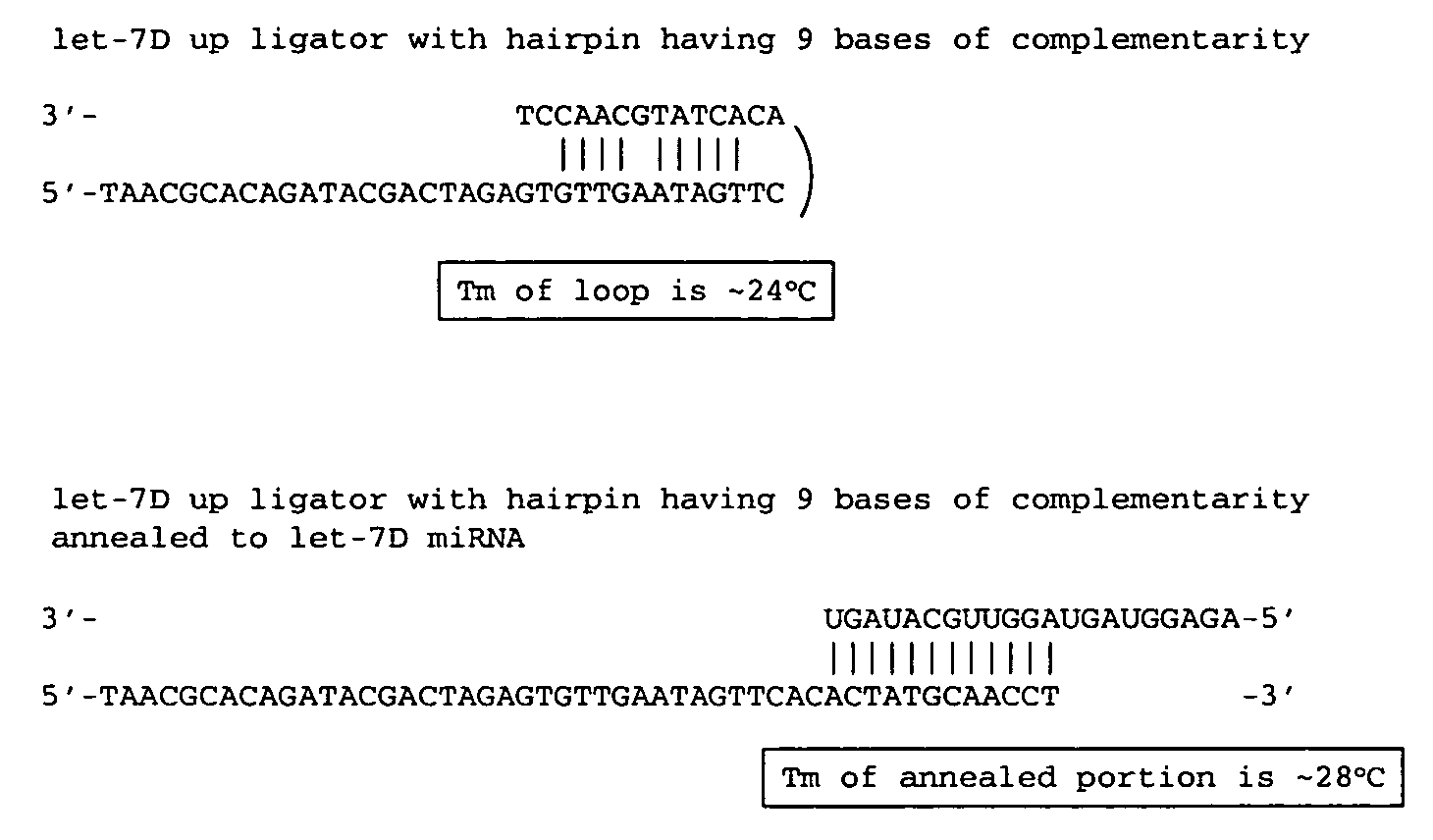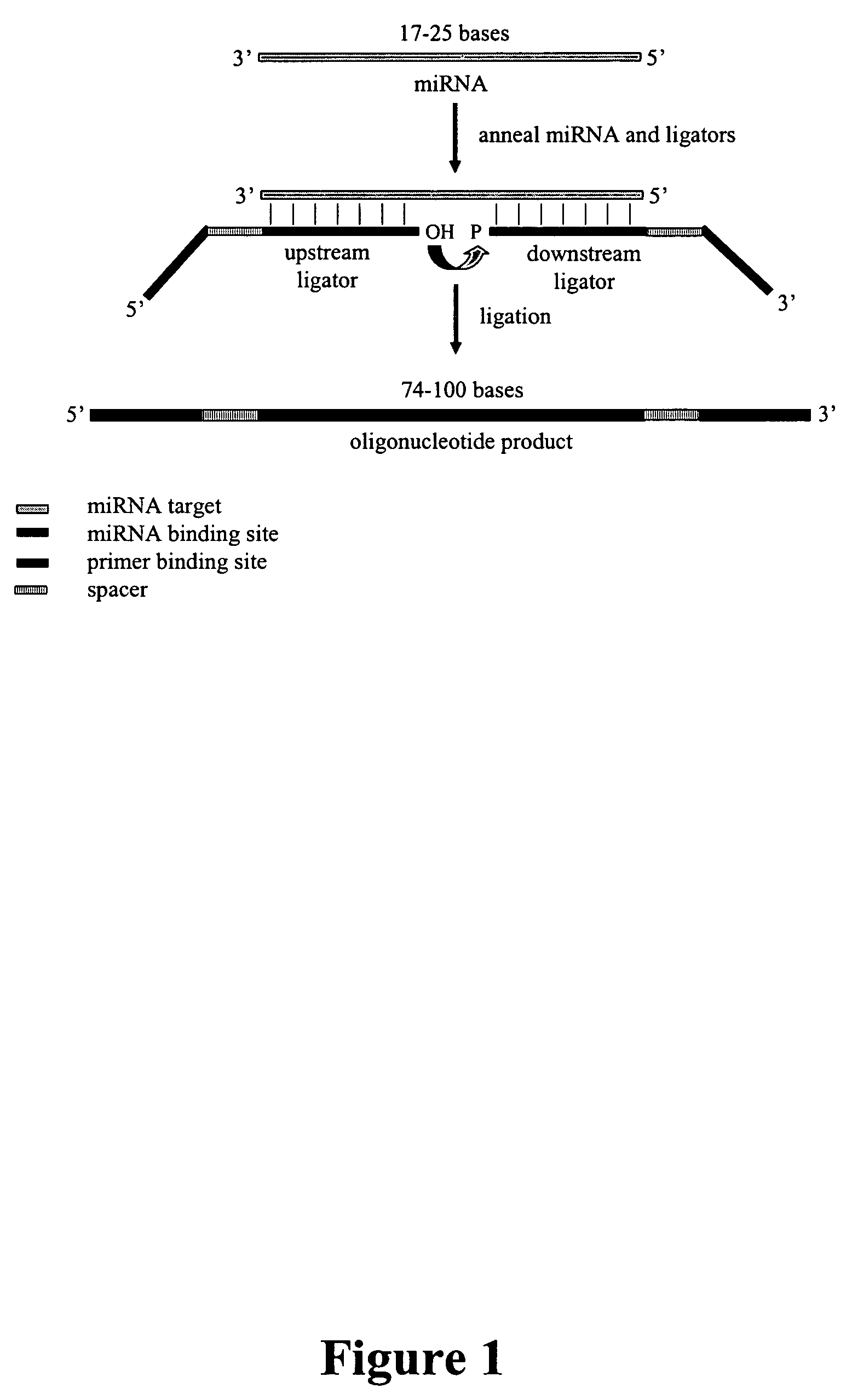Methods, compositions, and kits for detection of microRNA
- Summary
- Abstract
- Description
- Claims
- Application Information
AI Technical Summary
Benefits of technology
Problems solved by technology
Method used
Image
Examples
example 1
Ligation Reactions Using Synthetic RNA Templates
[0144] For gel analysis, ligation reactions were performed in 50 millimolar (mM) Tris-HCl, pH 7.5, 5 mM dithiothreitol (DTT), 15 micromolar (uM) adenosine triphosphate (ATP), 4.5 mM MgCl2, 25 mM sodium chloride (NaCl), 30 mM potassium chloride (KCl), 0.1 or 0.4 uM each ligator oligonucleotide, 0.1 uM synthetic RNA template, and 10 U T4 DNA ligase (Stratagene). Ligation components (except the T4 DNA ligase) were combined and incubated at 80° C. for 3 min and 16° C. for 5 min. The T4 DNA ligase was added and the ligation reactions were incubated at 23° C. for 2 hours. After 2 hours, the ligation reactions were terminated by heating at 65° C. for 20 minutes and stored at 6° C. until further analysis.
[0145] For QPCR analysis, ligation reactions were performed in 50 mM Tris-HCl, pH 7.5, 5 mM dithiothreitol (DTT), 15 uM adenosine triphosphate (ATP), 4.5 mM MgCl2, 25 mM sodium chloride (NaCl), 30 mM potassium chloride (KCl), either 0.1 or 0...
example 2
Ligation Reactions Using miRNA Templates from Cell Samples
[0146] For QPCR analysis, ligation reactions were performed as described above, the amount of template was varied in the reactions from 75 to 100 ng. In most experiments, Torulla yeast RNA (Ambion) was added to the reactions to maintain a constant total RNA concentration. It should be noted that the percentage of miRNA in the RNA samples isolated from cells may vary depending upon the method used. Because the samples may comprise more than miRNA, results with these samples might not be accurate indicators of the sensitivity of the ligation-QPCR assay. Ligation components (except the T4 DNA ligase) were combined and incubated at 80° C. for 3 min and 16° C. for 5 min prior to adding the ligase. Ligation reactions were incubated at 23° C. for 2 hours. After 2 hours, the ligation reactions were terminated by heating at 65° C. for 20 minutes and stored at 6° C.
example 3
Analysis of Ligation Reactions
[0147] For gel analysis, 10 microliters (ul) of the 20 ul ligation reaction was combined with an equal volume of Novex® TBE-Urea Sample Buffer (2×) (Invitrogen), incubated at 70° C. for 3 min, and stored on ice. The samples were loaded into the wells of a 15% (w / v) TBE-Urea gel and the nucleic acids separated by electrophoresis at 180V until the bromophenol blue dye front was ⅔ to ¾ the length of the gel. The nucleic acids were then stained with SYBR Gold (Molecular Probes) and visualized with the Eagle Eye® II System (Stratagene) according to the manufacturer's recommended conditions.
[0148] For QPCR analysis, ligation reactions were diluted 1:10 in water and 2.5 ul of the diluted ligation was added to each QPCR. QPCR was performed using the Brilliant® SYBR® Green QPCR Master Mix (Stratagene) according to the manufacturer's recommended reaction and cycling conditions. The reaction conditions were as follows (25 ul reaction volume): 1× Brilliant® SYBR®...
PUM
| Property | Measurement | Unit |
|---|---|---|
| Composition | aaaaa | aaaaa |
| Secondary structure | aaaaa | aaaaa |
Abstract
Description
Claims
Application Information
 Login to View More
Login to View More - R&D
- Intellectual Property
- Life Sciences
- Materials
- Tech Scout
- Unparalleled Data Quality
- Higher Quality Content
- 60% Fewer Hallucinations
Browse by: Latest US Patents, China's latest patents, Technical Efficacy Thesaurus, Application Domain, Technology Topic, Popular Technical Reports.
© 2025 PatSnap. All rights reserved.Legal|Privacy policy|Modern Slavery Act Transparency Statement|Sitemap|About US| Contact US: help@patsnap.com



